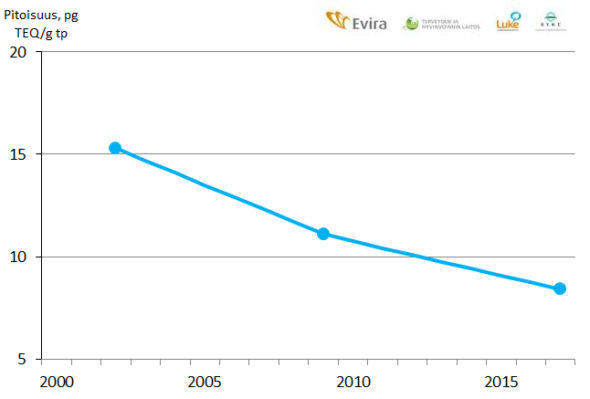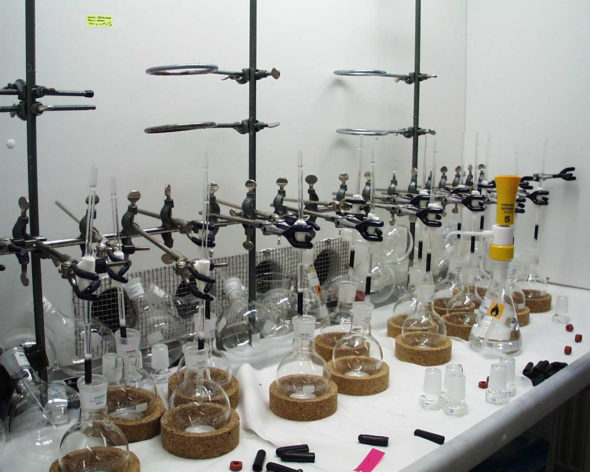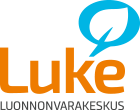Contaminants are compounds that have not been added to foodstuffs intentionally, but may be present in them e.g. as a result of food manufacturing processes or environmental contamination. In most cases, the presence of contaminants in foods cannot be completely prevented. In its amended form, the EU Regulation (EC No 1881/2006) sets the maximum limits for certain contaminants. If the maximum limits are exceeded, raw materials or products may not be placed on the market or used as food ingredients.
The maximum levels of environmental contaminants, dioxins, PCB compounds and heavy metals (cadmium, mercury and lead) are set for fish. In addition, maximum levels are defined for process contaminants such as PAH compounds related to smoked fish and fishery products.
Persistent and lipid-soluble pollutants tend to accumulate at the top of food chains. Dioxins as unwanted impurities and PCB compounds originate in industrial activities. They are persistent lipid-soluble compounds which accumulate in fatty fish species in particular. Concentrations of dioxin and PCB compounds in certain wild fish species in the Baltic Sea, such as salmon and herring, may exceed the legislative maximum allowable limits. With a permanent derogation, the marketing of these fish species and products made of them is permitted only in Finland and Sweden – and also in Latvia in the case of salmon.
The manufacture, use, formation and migration into the environment of many environmental contaminants is limited by international agreements and various technical solutions. Their concentrations in the environment have therefore clearly decreased and will continue to do so. The decline in environmental contaminants in Finnish fish has been noted, inter alia, in the EU Fish I (2001-2002)[1] and II projects (2009-2010).[2] The EU Fish III project, implemented in 2016-2018, will complement the information produced by previous projects on the environmental contaminants in Finnish fish.[3]
Concentration of dioxins and PCB compounds in salmon in the Baltic Sea

Source: EU-kalat III Project, Press release, Link
According to the initial results published by the EU Fish III project, levels of dioxins and PCB compounds have decreased in salmon to almost half of the 2002 levels measured by the EU Fish I project. The decrease was 27% from 2002 to 2009 and a further 24% up to 2017. The current EU Fish III project involves, in total, 115 composite samples of almost one thousand fish. The salmon were caught in May-June 2016. The reporting of the project on other fish species is ongoing.[4]

Coal Stack fractioning in which dioxins are separated from PCBs while removing impurities from the sample. Photo: Päivi Ruokojärvi
The dioxin contents in salmon have decreased, but are still above the maximum concentrations defined in EU legislation. According to the EU Regulation, fish for human consumption may contain a total maximum of 6.5 picograms of toxic equivalency (TEQ) per gram of fresh weight of fish of dioxin and PCB compounds. In the eight salmon samples analysed, each of which was composed of three specimens, these concentrations were 6.5-10.1 picograms TEQ/gram of fresh weight. Calculated for the second-sea-year salmon, the sum of dioxins and PCB compounds averaged 8.4 picograms TEQ per gram of fresh weight.
Freshwater fish, such as vendace, and low-fat fish in the Baltic Sea, do not have high PCB and dioxin concentrations, as organic halogen compounds mainly accumulate in fatty fish in the Baltic Sea.
Environmental contaminants only degrade the value of certain fish species as human food and feed raw material. Elevated levels of mercury have been observed, particularly in predatory fish in forest lakes with brown water in southern, central and eastern Finland. Methyl mercury and caesium-137 accumulate in predatory fish in lakes (pike, perch, pikeperch, burbot). The older the fish, the more contaminants it has accumulated. By avoiding the consumption of large predatory fish from lakes, consumers can avoid the accumulation of both mercury and radioactive caesium in their organs.[5]
Plenty of completely safe fish are available in Finland, since most non-predatory freshwater fish species contain very low quantities of environmental contaminants. In addition, in most of the Baltic fish species studied, including vendace, smelt, roach, perch, pike, pikeperch, whitefish, bream and burbot, the dioxin and PCB concentrations are low.
Fish is an excellent source of protein and beneficial omega-3 fatty acids, and the food authorities’ position is that fish should be used more often as a foodstuff in general. However, the Finnish Food Safety Authority Evira’s guidelines on safe consumption[6], particularly those for sensitive consumers, should be observed. The health benefits of eating fatty fish from the Baltic Sea, especially for people above middle age, outweigh the disadvantages of potential environmental contaminants from fish.[7] [8] Many fish species in the Baltic Sea and in lakes have very low concentrations of environmental contaminants and their use as a foodstuff should be encouraged.
References
[1] A. Hallikainen, H. Kiviranta, P. Isosaari, T. Vartiainen, R. Parmanne, P.J. Vuorinen (2004) Concentration of dioxins, furans, dioxin-like PCB compounds and polybrominated diphenyl ethers in domestic fresh water and salt water fish, National Food Agency publications 1/2004 Link to report
[2] Hallikainen, A., Airaksinen, R., Rantakokko, P., Koponen, J., Mannio, J., Vuorinen, P., Jääskeläinen, T., Kiviranta H. (2011) Environmental pollutants in Baltic fish and other domestic fish: PCDD/F, PCB, PBDE, PFC and OT compounds, Evira Research Reports 2/2011, 101 sivua, Link to report
[3] EU Kalat III Project site in Finnish
[4] EU Kalat III Press release in Finnish – Itämeren lohen dioksiinipitoisuudet ovat pienentyneet huomattavasti 2000 luvulla, Link to press release (in Finnish)
[5] Finnish Food Safety Authority Evira – Methylmercury and Cesium-137 in fresh water fish, Link
[6] Finnish Food Safety Authority Evira – Recommended intake of fish in Finnish and in Swedish
[7] Natural Resource Institute Finland – Fish and environmental toxicants, Link to the page
[8] Finnish Food Safety Authority Evira – Baltic herring as nutrition – Risk-benefit analysis, Link to report
Photo in upper edge: Jari Setälä
